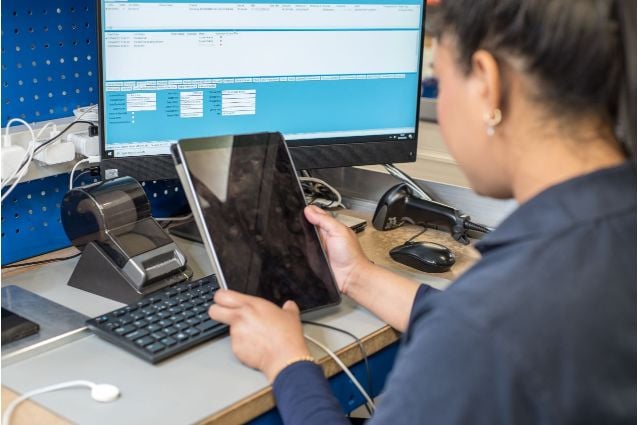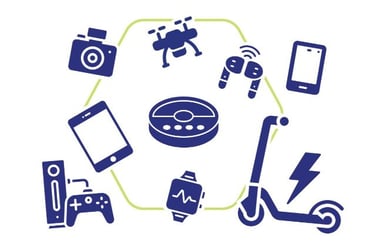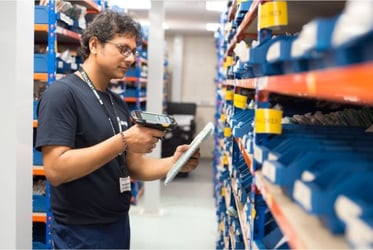Are you struggling to stay on top of your business IT requirements? Are you looking to make your IT processes more environmentally friendly? How about wanting to save time by streamlining IT workflow?
Failing to achieve these will waste time and resources while employees use aging, redundant equipment with outdated security and software, increasing the risk of data breaches.
Continuing to buy new technology adds to the CO2 emissions released during the manufacturing process.
You’re also subject to high capital expenditure.
What if there was a better solution?
The global DaaS (Device as a Service) market is expected to reach $455 billion by 2030, currently growing by 39.4% every year. More and more businesses are moving to the more economical approach.
Ingram Micro Lifecycle has worked within the technology and IT industry for over a decade. Through our close partnerships with OEMs, network operators, enterprises, and other markets, we can see the genuine value that the DaaS model offers. We’re primed to begin supporting our array of customers through these programs. The Ingram Micro Financial Solutions division is on hand to support DaaS financing for customers.
Below, we illustrate the business advantages of switching to a DaaS program.
What is DaaS?
This can mean Data as a Service or Desktop as a Service. In the context we refer to it here, DaaS means Device as a Service. Like many of the ‘as a Service’ models, it involves a shift away from purchasing to leasing.
The expenditure change shifts your upfront outlay from a capex cost to an ongoing monthly opex fee.
This model ensures you’re only paying for the technology you need when you need it. No more unused technology stored in cupboards, gathering dust, and posing a security risk.
As your business grows and employee requirements change, you can increase or decrease the volume of devices you use via lease.
DaaS offers a more rounded-out support package than just a lease. DaaS packages include technical support, pre-configuration of lease devices, simple staff onboarding, data wiping, and system management services. These are separate costs when purchasing technology.
Challenges of device management
There are several reasons why purchasing devices causes conflict within device management processes. These include:
Lack of visibility
This is an increasing challenge for businesses as flexible working surges in popularity. Inventory management is subject to human error. This can lead to mistakes when tracking device locations.
Outdated technology
Companies often buy new technology as new employees join. Employees who have been with the company longer have aging devices. They are often passed over for upgrades while new hires are given priority for new purchases.
This puts a strain on IT support as the breadth of technology within the business stretches. Support for older devices may fall by the wayside.
New hires within the IT department may not be as experienced in managing older devices. This decreases available support and increases the associated risks.
Maintenance
Older hardware needs increasing support as the condition deteriorates over time. Eventually, these will no longer support updates. The technology will age out of the market and become obsolete.
Aging technology leads to drains on productivity for the staff who are using them.
Security
Managing a variety of technology assets means staying on top of differing schedules for optimizing and updating security software. Different devices from different OEMs will have differing requirements and increases data risks if not kept up to date.
Increasing costs
Purchasing new technology is not the only outlay involved. There are added services you need to invest in for upgrades, updates, and maintenance. It can be impossible to predict the total investment of your technology as you won’t know the exact costs associated with the upkeep over its lifetime.
Lack of flexibility
As a way to reduce the upfront cost of devices, buying in bulk can give the benefit of a discount. However, this means you’re required to purchase the same device rather than a variety. This limits the ability to tailor your devices to individual job roles and requirements.
Lack of control
If your IT team is already stretched thin with support tickets, they have to prioritize those at the biggest risk. Employees are left to their own devices, with fewer touchpoints from support. Issues could arise from installation or use of unauthorized software that could be harmful.
Device disposal
The sustainability of our technology use is a growing concern. What do you do with IT assets when you no longer have a use for them?
Throwing them into landfill is harmful to the environment, and so too are some recycling programs if not handled correctly. ESG initiatives are driving businesses to reduce their corporate e-waste.
Navigating through the options for repair and recycling is easier with a reverse logistics partner who can help extend the lifecycle of your devices and promote your move to a circular economy.
Logistics
Failing to establish a central hub for deployment, configuration, kitting, and management of all IT devices that your company owns risks autonomy and the consistency of these processes.
10 benefits of DaaS
While the challenges above exist to some extent for all businesses, there’s a multitude of benefits of switching away from the upfront purchase model to utilizing device as a service programs.
1. Efficient
As mentioned above, this is more than just leasing. The DaaS package will include various services that work towards extending and maximizing the lifecycle of the IT estate.
2. Financial improvements
As lifecycle management is truly connected, you pay one fee for everything. No need to source additional partners for other services for additional costs.
As we mentioned in the opening, changing from a larger upfront cost to smaller ongoing monthly payments, shifts this from a capital expense to an operational one.
You pay for the technology you need as and when you have a use for it.
The model also enables insights into your technology usage trends and future needs for budgeting purposes.
3. Improved productivity
Configuration of devices will be completed ahead of your lease which means it’s provided to you or your employees ready to go, straight from the box. This removes the hassle of wait times and lengthy onboarding processes.
An estimated 1.8 billion working hours are wasted by UK office workers every year because the equipment they’re using isn’t efficient enough to meet their needs.
4. Expanded mobility and control
DaaS has the flexibility to pre-configure and directly send devices to wherever your employees work, a great approach when they’re more often out in the field or working from home.
Through device enrolment into a Mobile Device Management (MDM) plan, the DaaS provider can manage devices remotely and fully control any updates or support required. This increases your visibility and data safety.
5. Frees up the time of IT teams
IT departments are often fighting against an oncoming wave of minor support tickets which monopolizes their time from thinking and planning strategically.
Helpdesk requests become streamlined with direct end-user support provided under the leasing contract.
Your IT employees have their time released to focus on tasks that have a larger impact on the profitability of the company and its operations.
The ability to focus the in-house IT team on strategic projects was a key benefit of DaaS, according to 55% of medium companies and 49% of large companies.
Your IT employees can enjoy bigger-picture projects while your end-users benefit from a better, more efficient experience.
6. ESG advantages
Moving from an ownership approach to a leasing one supports the circular economy as it promotes the lifecycle extension of devices.
Making the most of technology already in existence releases the pressure on manufacturing new. This leads to a reduction in CO2 emissions released during the manufacturing process.
It’s predicted that by 2040, the production of IT devices will account for 14% of total greenhouse emissions. 80% of the lifetime CO2e from IT assets are released at the point of manufacturing and logistics.
7. Winning the war for talent
Jobseekers are looking for the best packages when looking for employment and this includes being able to work with the latest technology. Being presented with aging or obsolete equipment on their first day is not going to appeal to your new starter.
Remain an attractive proposition without having the upfront outlay.
8. Availability of technology
Covid may be retreating into the shadows of yesteryear but the impacts on the supply chain are still being felt.
DaaS suppliers are always receiving used products back into their inventory ahead of repair and refurbishment. These become available for re-use and can become a more easily accessible option than brand-new technologies elsewhere.
9. Improved security updates
As your devices are part of an ongoing servicing program, they will be subjected to regular security checks and updates.
These are not only throughout your lease period but also when a device is returned. You have the assurance that every device you received has gone through stringent checks and procedures to maintain compliance.
10. Improved user experience
With any kind of service provision, the satisfaction of the end user is always paramount to its success. When it comes to technology, this is largely influenced by the levels of productivity and connectivity that we can achieve. Maximize these and satisfaction is likely to be higher.
Streamlining communication with end users, minimizing their downtime, and making them feel supported is key.
When supported by a DaaS program provider, the end user interacts directly with the partner as opposed to the internal IT team. This takes the pressure off the IT team and ensures dedicated support should any issues occur.
Your users will be given access to a dedicated web-based portal to log into and report issues with their leased devices. This 24/7 e-ticketing system provides tracking and insights into the technical issues that users are experiencing.
Are you ready to move to DaaS?
We’ve covered various struggles that businesses are facing in today’s constantly shifting landscape. You have to remain agile to keep competitive. DaaS provides many benefits that help promote this, including releasing your IT teams to be strategic, enabling better financial forecasting, and keeping your devices refreshed and out of obsolescence.
If you’re interested in finding out more about how Ingram Micro Lifecycle can support your DaaS program, reach out to our team today.














